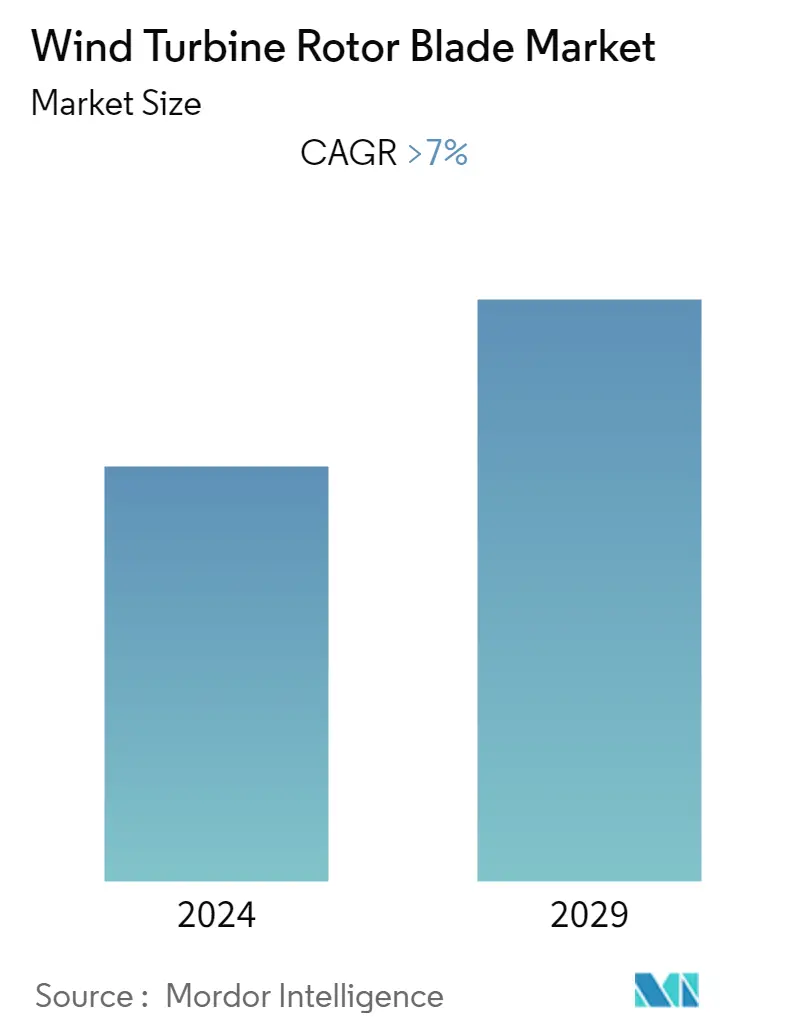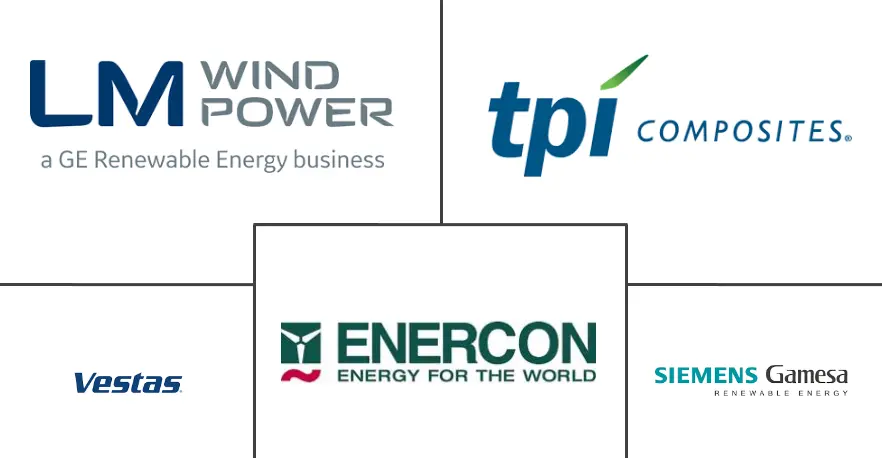Market Size of Wind Turbine Rotor Blade Industry

| Study Period | 2020 - 2029 |
| Base Year For Estimation | 2023 |
| CAGR | > 7.00 % |
| Fastest Growing Market | Asia-Pacific |
| Largest Market | Asia Pacific |
| Market Concentration | Low |
Major Players
*Disclaimer: Major Players sorted in no particular order |
Wind Turbine Rotor Blade Market Analysis
The Global Wind Turbine Rotor Blade Market size was estimated at about USD 20.49 billion in the current year and is projected to register at a CAGR of more than 7% during the forecast period.
The market was moderately impacted by COVID-19 in 2020. Presently, the market has reached pre-pandemic levels.
- The major driving factor of the market is the growing number of offshore and onshore wind energy installations across the world.
- On the flip side, the associated high cost of transportation and cost competitiveness of alternate clean power sources, like solar power, hydropower, etc., have the potential to hinder market growth.
- The wind power industry has been in demand for cost-effective solutions, and a highly efficient product has the potential to change the dynamics of the industry. There were instances where old turbines were replaced, not because of the damage but due to the availability of more efficient blades in the market. Hence, technological developments present themselves as opportunities for the wind turbine rotor blade market.
- Asia-Pacific dominated the wind turbine rotor blade market in 2022, with the majority of the demand coming from countries like China, India, and Australia.
Wind Turbine Rotor Blade Industry Segmentation
Wind turbine rotor blades are the key components of wind turbines, as they are in direct contact with high-speed winds. Rotor blades convert wind's kinetic energy into rotational energy, which is later converted into electrical energy. The global wind turbine rotor blade market is segmented by location of deployment, blade material, and geography. By location of deployment, the market is segmented into onshore and offshore. By blade material, the market is segmented by carbon fiber, glass fiber, and other blade materials. The report also covers the market size and forecasts for the wind turbine rotor blade market across major regions, namely North America, Europe, Asia-Pacific, South America, and Middle East and Africa. For each segment, the market sizing and forecasts have been done based on revenue (USD Billion).
| Location of Deployment | |
| Onshore | |
| Offshore |
| Blade Material | |
| Carbon Fiber | |
| Glass Fiber | |
| Other Blade Materials |
| Geography | |
| North America | |
| Europe | |
| Asia-Pacific | |
| South America | |
| Middle East and Africa |
Wind Turbine Rotor Blade Market Size Summary
The wind turbine rotor blade market is experiencing significant growth, driven by the increasing installation of offshore and onshore wind energy systems globally. The market has rebounded to pre-pandemic levels after a moderate impact from COVID-19. Technological advancements in rotor blade efficiency are creating opportunities, as older turbines are being replaced with more efficient models. However, challenges such as high transportation costs and competition from alternative clean energy sources like solar and hydropower could impede growth. The Asia-Pacific region, particularly China, India, and Australia, leads in demand, with substantial contributions from these countries' expanding wind energy capacities.
The onshore wind energy sector is evolving, with larger turbines and blades being developed to maximize energy production and expand into areas with lower wind speeds. Despite a slowdown in onshore wind installations in major markets like China and the United States, regions such as Europe, Latin America, Africa, and the Middle East have seen robust growth. The declining levelized cost of energy and capital expenditures, along with ambitious renewable energy targets in countries like China, the United States, and India, are expected to drive demand for wind turbine rotor blades. The market is characterized by fragmentation, with key players including TPI Composites, LM Wind Power, Siemens Gamesa Renewable Energy, Vestas Wind Systems, and Enercon GmbH, who are actively involved in innovations such as recyclable blade technologies.
Wind Turbine Rotor Blade Market Size - Table of Contents
-
1. MARKET OVERVIEW
-
1.1 Introduction
-
1.2 Market Size and Demand Forecast in USD billion, till 2027
-
1.3 Wind Turbine Rotor Blades Price Analysis
-
1.4 Recent Trends and Developments
-
1.5 Government Policies, Regulations, and Targets
-
1.6 Market Dynamics
-
1.6.1 Drivers
-
1.6.2 Restraints
-
-
1.7 Supply Chain Analysis
-
1.8 Porter's Five Forces Analysis
-
1.8.1 Bargaining Power of Suppliers
-
1.8.2 Bargaining Power of Consumers
-
1.8.3 Threat of New Entrants
-
1.8.4 Threat of Substitutes Products and Services
-
1.8.5 Intensity of Competitive Rivalry
-
-
-
2. MARKET SEGMENTATION
-
2.1 Location of Deployment
-
2.1.1 Onshore
-
2.1.2 Offshore
-
-
2.2 Blade Material
-
2.2.1 Carbon Fiber
-
2.2.2 Glass Fiber
-
2.2.3 Other Blade Materials
-
-
2.3 Geography
-
2.3.1 North America
-
2.3.2 Europe
-
2.3.3 Asia-Pacific
-
2.3.4 South America
-
2.3.5 Middle East and Africa
-
-
Wind Turbine Rotor Blade Market Size FAQs
What is the current Wind Turbine Rotor Blade Market size?
The Wind Turbine Rotor Blade Market is projected to register a CAGR of greater than 7% during the forecast period (2024-2029)
Who are the key players in Wind Turbine Rotor Blade Market?
TPI Composites SA, Vestas Wind Systems A/S, Enercon GmbH, LM Wind Power (a GE Renewable Energy business) and Siemens Gamesa Renewable Energy, S.A. are the major companies operating in the Wind Turbine Rotor Blade Market.

